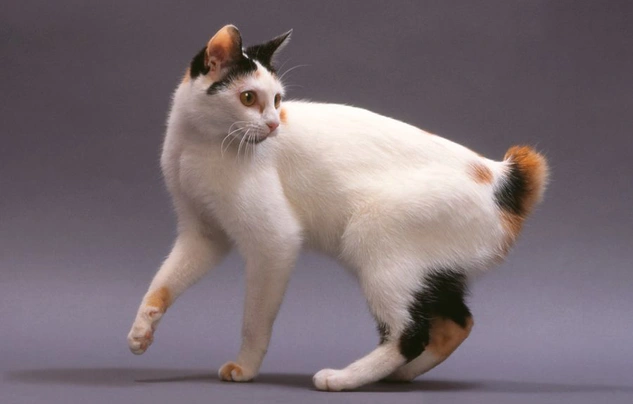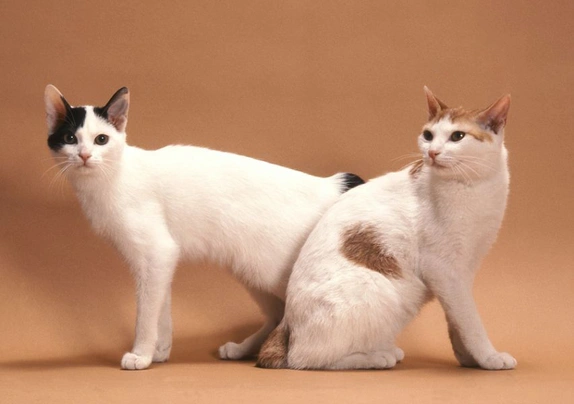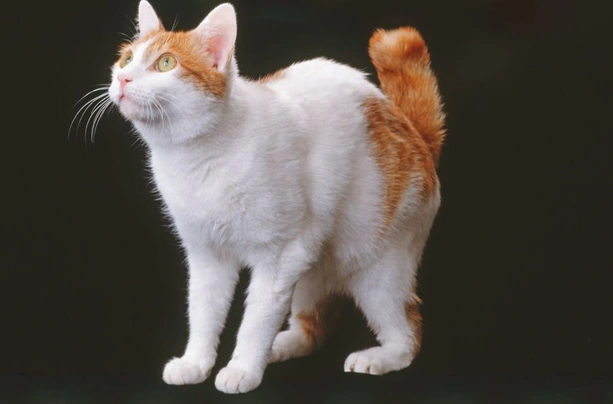Japanese Bobtail
Introduction of the Japanese Bobtail
This breed of domestic cat is native to Japan and South-East Asia and has now been bred in the USA on a small scale for over 40 years. However it is rarely seen in the UK as it is not recognised by the Governing Council of the Cat Fancy (GCCF) and therefore cannot be shown at GCCF shows.
The Japanese Bobtail is the national cat of Japan and is also associated with good fortune supposedly linked to it having a short tail as longer-tailed varieties were thought to represent evil.
One story regarding the short tail recounts an incident of a sleeping cat whose long tail caught fire and then ran through town spreading flames everywhere. With the Capital in ashes it is said the Emperor decreed that all cats should have their tails cut short as a preventative measure. Sailors in Japan have adopted the Bobcat as a talisman to ward off storms at sea because the naturally recurring bobtail resembles a chrysanthemum the emblem of the royal family. The Beckoning Cat of Japan (with one raised paw) a Japanese Bobcat is also a symbol of good luck as ancient legends say that a group of Samurai warriors were led from a storm to the temple by such a cat.
Japanese around the world keep statues of this cat as a good luck charm to ward off evil. Japanese Bobtails feature prominently in traditional Japanese painting and today the modern cartoon character Hello Kitty is depicted as a Japanese Bobtail as an example of Japanese pop culture.
History of the Japanese Bobtail
With such an ancient breed as the Japanese Bobtail stories of its origins have mostly come down from ancient legend rather than by documented history. Although legend says that cats arrived in Japan from China in 999AD with ownership restricted to the aristocracy for about five centuries the truth is probably more closely linked to the spread of cats through Asia hundreds of years earlier. It is known that cats with stumped or bobbed tails were amongst the original feline immigrant population and with the restricted gene pool in Japan at the time the recessive gene for the bobbed tail would have flourished. The first record of Japanese Bobtails being exported to the West from their native country was in 1968 when an American breeder Elizabeth Freret established the first breeding programme outside of Japan with three imported shorthaired cats. They were initially recognised by the Cat Fanciers' Association (CFA) in 1971 and given full Championship status in 1976. Their popularity spread slowly with a few dedicated breeders but it is still quite a rare breed. In 1993 the longhaired variety was also accepted for registration by the CFA after an American judge saw this version at a cat show in Japan and arranged for longhaired Japanese Bobcats to be imported into the USA.
Appearance of the Japanese Bobtail
The Japanese Bobtail can be either a shorthaired or semi-longhaired variety and is distinguishable by its very short tail about three to four inches long that curls back slightly over its back giving an impression of a rabbit's 'scut' and is an elegant medium-sized cat with long clean lines and fine bone structure. The original cats were all shorthaired although the cats imported to America were later found to carry the longhaired gene. The traditional Japanese Bobtail was predominantly white with patches of red and white known as 'mi-ke' which literally means 'triple-hair' that is 'tricolour' in the West. The Japanese Bobtail now comes in a wide array of patterns including self (the same colour all over) tortie pointed all varieties of tabby and bi-colour and colours include black blue red brown silver and white. Although the head appears long and finely chiselled it forms an almost perfect equilateral triangle with gentle curving lines and high cheekbones and large expressive ears. The large round eyes are set at a slant giving the cat a wide-awake expression and the colour depends on the coat colour. Odd-eyed Japanese Bobcats are occasionally seen usually on a cat with a predominantly white coat colour and this is perfectly acceptable. The legs are slender and long with the hind legs being noticeably longer than the front legs and the paws are oval. The iconic tail is carried upright when the cat is relaxed and the hair is generally thicker and longer than elsewhere on the body growing in all directions to give a pom-pom effect.
Temperament of the Japanese Bobtail
The Japanese Bobtail is considered to be an intelligent breed of cat and is very human-orientated. They are very chatty with their humans and have a wide range of vocal tones supporting the Japanese legend that they are able to sing! They love to please their owners and are not as demanding as many other breeds happy to just have human company and not liking to be left alone. This breed gets on well with other cats and cat-tolerant dogs and is child-friendly making it an ideal family pet as it is so sociable. Owners report that the Japanese Bobtail will adapt well to a harness if required although they will be perfectly happy living indoors so long as they have human or animal company.
Intelligence / Trainability of the Japanese Bobtail
The modern Japanese Bobtail is not known to have any breed-specific health problems and many live to around the age of 15 years. In common with other cats they need annual vaccination boosters against the common feline ailments of flu and enteritis as well as against Feline Leukaemia if they go outdoors.
Children and other
They are not known to be fussy eaters and will eat most good quality proprietary brands of cat food but will also enjoy treats of cooked chicken ham and grated cheese. However cows' milk will probably give them a stomach upset and a bowl of water should always be available. The shorthaired variety needs very little grooming apart from stroking and gentle brushing to remove loose hairs although the longhaired Japanese Bobtail will need regular brushing and combing to prevent the build up of knots and tangles.
Health of the Japanese Bobtail
Caring for the Japanese Bobtail
Grooming of the Japanese Bobtail
Exercise of the Japanese Bobtail
Feeding of the Japanese Bobtail
Japanese Bobtail price



